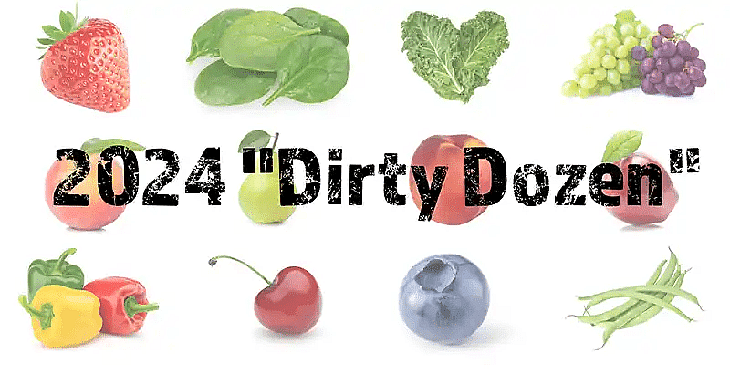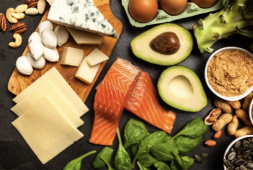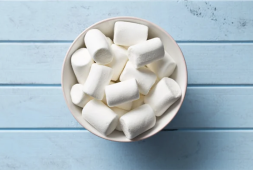
The yearly analysis by the Environmental Working Group also pinpoints the ‘Clean Fifteen’, which are the produce with the lowest pesticide residue. Conversely, non-organic spinach, blueberries, strawberries, and green beans made it onto this year’s ‘Dirty Dozen’ list.
Main Points to Remember
- The Environmental Working Group has published its yearly compilation of the top twelve fruits and vegetables known as the “Dirty Dozen,” which have the highest pesticide residues.
- To minimize exposure to pesticides, consider purchasing organic produce or wash conventional items thoroughly with a solution of baking soda or vinegar.
- Nutritionists stress the importance of consuming ample amounts of fruits and vegetables, whether organic or conventional, for overall health.
Recent government lab tests revealed the presence of pesticides in various nonorganic fruits and vegetables, including strawberries, spinach, grapes, peaches, and kale, among others. According to the latest report, nearly all nonorganic strawberries, spinach, grapes, peaches, and leafy greens like kale contained detectable levels of pesticides.
These specific fruits and vegetables have consistently made the Environmental Working Group’s “Dirty Dozen” list, featured in their 2024 Shopper’s Guide to Pesticides in Produce.
The report highlights that 95 percent of the samples of these 12 nonorganic fruits and vegetables had detectable levels of pesticides. Kale, collards, and mustard greens topped the list this year with the highest pesticide residue, detecting 103 individual chemicals. Following closely were hot peppers, with 101 chemicals found.
“Everyone — adults and kids — should eat more fruits and vegetables, whether organic or not,” Alexa Friedman, PhD, a senior scientist at EWG, spoke in a recent statement. “But consumers concerned about pesticide exposure can use the suite of materials in EWG’s Shopper’s Guide to Pesticides in Produce to make the best choices for them and their families.”
List of Fruits and Vegetables on the ‘Dirty Dozen’
According to an analysis by the EWG of government testing, the following produce showed the highest levels of pesticides (not listed in any particular order):
- Strawberries
- Spinach
- Kale, collards, and mustard greens
- Grapes
- Peaches
- Pears
- Nectarines
- Apples
- Bell and hot peppers
- Cherries
- Blueberries
- Green beans
Pesticides Found in the ‘Dirty Dozen’
The Environmental Working Group (EWG) report highlights that among the most frequently detected chemicals in food, four out of five are fungicides. Notably, fludioxonil and pyrimethanil, two of these fungicides, were found in the highest concentrations among all pesticides in the twelve most contaminated foods. These fungicides are categorized as endocrine disruptors because they interfere with crucial hormone systems responsible for various aspects of growth and reproduction in the body.
Fungicides are commonly found on nonorganic fruits and vegetables due to their application during plant growth to prevent or eliminate fungal infections like mildew. Additionally, they are applied post-harvest to maintain produce quality and prevent mold during transit to stores, as per the EWG.
Before testing by the U.S. Department of Agriculture (USDA), produce undergoes peeling, scrubbing, and washing. Despite these measures, evidence of 254 different pesticides was found on fruits and vegetables, with 209 different pesticides detected on produce from the “Dirty Dozen” list, according to the EWG.
List of Fruits and Vegetables Found in the ‘Clean Fifteen’
The EWG also compiled a “Clean Fifteen” list of non-organic produce with minimal or no detected pesticides in lab tests. This list includes:
- Avocados
- Sweet corn
- Pineapple
- Onions
- Papaya
- Frozen peas
- Asparagus
- Honeydew melon
- Kiwi
- Cabbage
- Watermelon
- Mushrooms
- Mangoes
- Sweet potatoes
- Carrots
These items are listed in no particular order.
The Environmental Working Group (EWG) found that nearly 65 percent of the samples for these foods showed no detectable pesticides.
This Shouldn’t Stop You from Eating Fruits and Vegetables, Even if It’s Not Organic
Reducing your exposure to pesticides, even if you can’t afford organic produce, is possible, according to Luz Claudio, PhD, a professor of environmental medicine and public health at the Icahn School of Medicine at Mount Sinai in New York City.
One strategy is to prioritize your purchases. You can confidently buy nonorganic fruits and vegetables from the “Clean Fifteen” list, reserving your organic budget for items on the “Dirty Dozen” list, which tend to have higher pesticide residues.
Moreover, washing produce thoroughly with water and using a solution of baking soda or vinegar can help remove some pesticide residue, advises Dr. Claudio. Peeling produce can also reduce chemical exposure, though this may remove some nutrients.
Despite potential pesticide exposure from nonorganic produce, Samantha Heller, RD, a clinical dietitian in New York City, emphasizes that the benefits of consuming a diet rich in fruits and vegetables far outweigh the risks.
“All fruits, vegetables, nuts, seeds, whole grains, and beans are healthy foods whether they are organic or not,” Heller said.
“Adopting a more plant-based dietary lifestyle is healthy for the individual and the planet,” Heller added. “We do not want to scare people away from eating perfectly healthy foods even if they are not organic.”
Study Stresses Importance of Safer Agribusiness Practices
According to Claudio, although the EWG shopping guide serves as a valuable tool for individuals seeking to minimize their pesticide exposure, particularly those unable to consistently purchase organic produce due to financial constraints, it falls short in tackling the root causes of pesticide utilization within agricultural and business frameworks.
She also said, “It is equally important to advocate for and adopt safer agricultural practices that reduce exposures to farmworkers, ecosystems, wildlife, and beneficial insects, and ultimately helps to reduce some of the collateral damage being caused by excessive use of synthetic chemicals and other potentially harmful agribusiness farming practices.”



